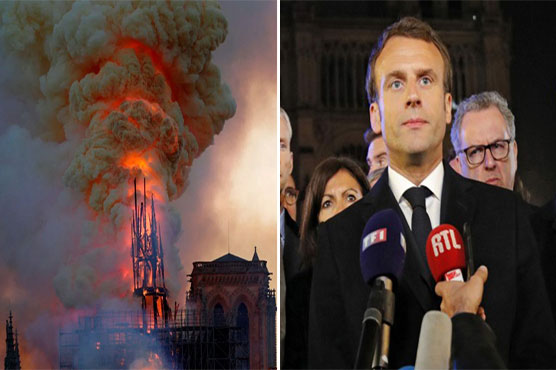Macron vows to rebuild Notre-Dame after devastating fire

French President Emmanuel Macron on Monday vowed to rebuild Notre-Dame Cathedral in Paris.
PARIS (AFP) - French President Emmanuel Macron on Monday vowed to rebuild Notre-Dame Cathedral in Paris, after a colossal fire caused the spire of the historic edifice to crash to the ground and wiped out centuries of heritage.
Macron expressed relief that "the worst had been avoided" in a fire that risked bringing the entire edifice down and left France in shock over the damage to a building described as the soul of the nation.
But the blaze destroyed the roof of the 850-year-old UNESCO world heritage landmark, whose spectacular Gothic spire collapsed before the eyes of horrified onlookers on a previously pristine early spring evening.
The fire, which came as Catholics prepare to celebrate Easter, sent orange flames and clouds of grey smoke billowing into the sky as stunned Parisians and tourists watched on in horror.
As darkness fell, some 400 firefighters then battled to control the blaze and save at least its iconic front towers. They finally gained the upper hand as midnight approached.
Paris fire brigade chief Jean-Claude Gallet said "we can consider that the main structure of Notre-Dame has been saved and preserved" as well as the two towers.
Deputy Interior Minister Laurent Nunez, also present at the scene, said that for the first time "the fire had decreased in intensity" while still urging "extreme caution".
"Notre-Dame survived all the wars, all the bombardments. We never thought it could burn. I feel incredibly sad and empty," Stephane Seigneurie, a consultant who joined other shocked onlookers in a solemn rendition of "Ave Maria" as they watched the fire from a nearby bridge.
Gasps and cries of "Oh my god" erupted around an hour after the fire first broke out when the top portion of the church s spire came crashing down.
"We have been dealt a knockout blow," a stricken-looking Paris Archbishop Michel Aupetit told reporters.
The cause of the blaze was not immediately confirmed. The cathedral had been undergoing intense restoration work which the fire service said could be linked to the blaze.
French prosecutors said it was being treated as an "involuntary" fire, indicating that foul play was ruled out for now.
Historians expressed incredulity at the collapse of a building that has been a symbol of France for almost a millennium and withstood war and revolution.
"If Paris is the Eiffel Tower then France is Notre Dame. It s the entire culture, entire history of France incarnated in this monument," Bernard Lecomte, a writer and specialist in religious history told BFM TV.
Deputy Paris mayor Emmanuel Gregoire told the channel that workers were scrambling "to save all the artworks that can be saved." Officials later said teams had managed to salvage an unknown quantity of the cultural treasures.
Macron had earlier cancelled a major televised policy speech he was due to give on Monday evening to respond to months of protests, and instead headed to the scene in person.
Visibly emotional, he said while the "worst had been avoided" and the facade and two towers saved "the next hours will be difficult".
"And we will rebuild Notre-Dame because it is what the French expect," he said, describing Notre Dame as "the epicentre of our life" and the cathedral of "all the French", whether religious or not.
France s billionaire Pinault dynasty immediately pledged 100 million euros for the effort.
German Chancellor Angela Merkel called Notre-Dame cathedral a "symbol of European culture" as the blaze raged.
The Vatican on Monday expressed its "incredulity" and "sadness", expressing "our closeness with French Catholics and with the Parisian population."
There was no immediate indication of any casualties in the blaze.
US President Donald Trump in a tweet said it was "horrible" to watch the fire but caused controversy by offering advice on how to put it out.
"Perhaps flying water tankers could be used to put it out. Must act quickly!" he said.
But France s civil security service, which oversees crisis management in the country, tweeted back at Trump that the use of water-bombing aircraft was not being considered.
"If used, (this) could lead to the collapse of the entire structure of the cathedral," it said.
The cathedral was located at the centre of the French capital in the Middle Ages and its construction was completed in the mid-12th century after some 200 years of work.
During the French Revolution in the 18th century, the cathedral was vandalised in widespread anti-Catholic violence: its spire was dismantled, its treasures plundered and its large statues at the grand entrance doors destroyed.
It would go on to feature as a central character in a Victor Hugo novel published in 1831, "The Hunchback of Notre-Dame" and shortly afterwards a restoration project lasting two decades got under way, led by architect Eugene Viollet-le-Duc.
It would survive the devastation of two world conflicts in the 20th century and famously rang its bells on August 24, 1944, the day of the Liberation of Paris from German occupation at the end of the World War II.
"Paris is disfigured. The city will never be like it was before," said Philippe, a communications worker in his mid-30s, who had biked over to the scene after being alerted of the fire by a friend.
Jacky Lafortune, a 72-year-old artist and self-described atheist stood forlornly on the banks of the River Seine staring at the cathedral.
Comparing the mood in the French capital to the aftermath of a terror attack he said: "But this stirs much deeper emotions because Notre-Dame is linked to the very foundations of our culture."


